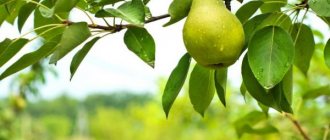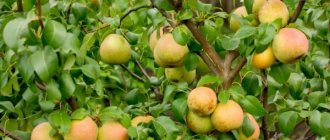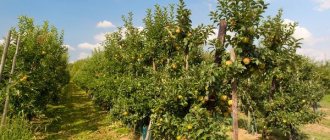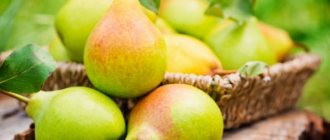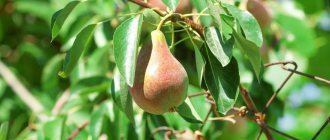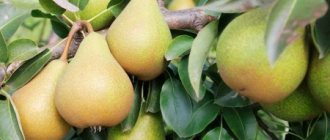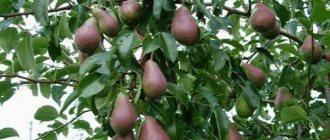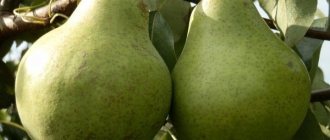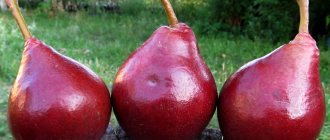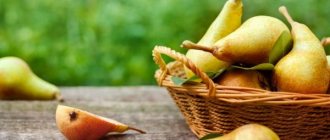Pear Lyra.
Description of the variety
The Lyra pear is part of the group of autumn ripening varieties. The variety is perfect for growing in the Central Black Earth region.
Characteristics of wood
The trees are medium to vigorous. The height of an adult pear is usually about 5 meters. The crown is wide, medium-thick, pyramid-shaped. The bark on the shoots is brownish-brown in color. The leaves are medium in size, dark green, oval. The leaf blade is smooth and shiny.
Description of fruits
Lyra.
Pears are large, weighing about 200 grams. The shape of the fruit is broadly pear-shaped, sometimes slightly elongated. At consumer ripeness, the fruits are light yellow.
On the surface of the pears there is a reddish blush and a large number of subcutaneous dots of gray-green color. The taste of the fruits is very juicy, sweet, with a slight sourness and a light aroma.
The fruits are removed from the tree in the second half of September, but they reach consumer maturity only after 1-2 weeks. The harvest can be stored until the end of December.
Main characteristics
The Lyra pear is a tall tree characterized by rapid growth. The shoots are medium thick, brown-brown in color, glabrous. They grow in an arched manner. The crown is wide, pyramidal in shape, not too thick. The leaves are dark green, ovate, slightly elongated, with a pointed end, smooth and shiny.
Flowering occurs around mid-May. The flowers have five white petals. Collected from the inflorescence. Depending on weather conditions, flowering lasts up to two weeks. The flowers have a pleasant aroma that attracts pollinating insects. Thanks to late flowering, the inflorescences are not subject to return frosts, which ensures stable yields.
The ovaries are formed mainly on the ringlets and spears.
Fruits reach ripeness by mid-September. At this time they are collected and left to ripen for about another month. Their petiole is of medium length, thickened, and easily detaches from the branch. It is necessary to harvest the crop on time, since the fruits can fall off the tree under the influence of strong winds.
The plant has good winter hardiness and can withstand frosts down to -30 C. In addition, it is highly resistant to the fungal disease scab, which often affects fruit crops (especially in rainy years).
Reviews
Gregory
Michurinsk
I'm very pleased with this pear. The tree quickly began to bear fruit and produces good harvests. The fruits are stored for a long time and are not afraid of transportation.
Ilona
Livny
Our children love these pears very much, so we put most of the harvest into storage. The fruits are very tasty and juicy.
Nikolai
Bryansk
The pear grows in the country, where I rarely visit. The tree feels great and produces good harvests, even without my special participation.
Landing
The tree feels best on light, fertile soils. Detailed instructions for selecting and preparing a seat can be found by clicking on the links below. There is also a complete description of the technology for planting the Lira pear variety.
How to plant a pear tree correctly
At what distance to plant pears?
How to choose pear seedlings
How to replant a pear
Pear Lyra: description and characteristics, features of planting and care, photo
Beginning gardeners do not dare to plant a pear on the plot without gaining enough experience, because they have heard about the fastidiousness of this plant. But there are varieties that can be grown without experience. One of these varieties is Lyra.
Description of the Lira pear variety
Lyra is an early winter variety intended for cultivation in central Russia, throughout Ukraine and the larger (southern) part of Belarus. Under favorable conditions and the use of certain agricultural techniques, the variety can be grown in more northern latitudes.
The developer of Lyra is the All-Russian Scientific Research Institute for Breeding Fruit Crops, where the variety was bred as a result of crossing the varieties Bere Michurina Zimnaya and Lesnaya Krasavitsa.
The tall tree has a moderately dense crown shaped like a pyramid. The leaf is medium, the buds are cone-shaped. Flowers are grouped into medium-sized inflorescences. Small, elongated leaves have a matte surface. The stalk is short and can break with significant gusts of wind.
The fruit weighs 190–215 g, with a typical pear shape. The peel is smooth, yellow-green, and turns red with maturity. It has excellent taste, contains a lot of juice, and has a soft, creamy texture. The chamber with the seeds is closed.
The fruits contain:
- sugar - 8%;
- organic acids - 0.1%;
- vitamin C - 14.0 mg/100g.
The approximate ripening time is the second ten days of September (at the latitude of Bryansk-Bobruisk).
Allegro pear flavor
The taste is typical of a pear: characteristic sweetness with an emphasized, pleasant, moderately sour aftertaste.
Please also pay attention to other winter ripening pear varieties:
Pear pollinators
The tree is self-fertile, however, it would not be superfluous to plant several pears of different varieties nearby in terms of flowering dates. This procedure helps to increase productivity.
Pros and cons of the variety
- The most significant advantages of Lyra:
- excellent taste and product qualities;
- early onset of fruiting;
- decent yield indicators;
- keeping quality and transportability.
Observations and analysis of specialists, the experience of amateur gardeners give reason to assert that Lyra has a significant disadvantage - frost resistance is not its strong point.
Productivity
The variety has a high stable yield. When grown in industrial quantities, up to 180 centners of fruit can be harvested per hectare; one tree per season can produce 65–80 kg of juicy pears.
Planting and caring for pears
The main points of planting and caring for Lyra are the same as those that apply to other varieties. Keeping some rules in mind and following the recommendations, there should be no difficulties with these procedures.
Optimal growing conditions
The most favorable conditions for growing any fruit tree consist of several factors.
The most important things for growing pears are:
- Place. The best place would be a small hillock open to sunlight. A sloping slope that descends in a southerly direction is also suitable. The advantage of elevation is that groundwater lies deep in such places. If the site is fenced from the north by plantings or some buildings, we can assume that you have found the ideal place.
- The soil. The best option for Lyra is light loamy soil with a pH of 6.0-7.0. The tree is comfortable in such soil, however, it is not always possible to find such a place. If the soil on the site contains a lot of clay, add peat and river sand when digging. If the soil is rich in sand, add peat and compost.
You can plant a tree in spring or autumn, both methods have advantages and disadvantages. On the one hand, by planting a tree in the fall, you give it the opportunity to take root before the onset of cold weather. With the arrival of winter, the tree will “go into hibernation”, and the root system, with proper pre-winter watering, will develop.
As soon as the earth begins to warm up and climatic conditions allow, the pear will wake up and begin to grow green. Plants planted in the fall begin to bear fruit about half a month earlier.
On the other hand, when planted in autumn, the tree can become a victim of severe frosts (the frost resistance of the variety is average), winters with little snow, and strong winds. In addition, rodents pose a danger.
Important! The distance between neighboring trees or a pear tree and any structure must be at least 4 m.
You should proceed from the specific climatic characteristics of your region. Choosing the right approximate planting date is simple: at least 26 days must pass after the tree is in the ground and before frost sets in . The approximate time for planting a tree in spring is late March - early April.
Landing rules and technology
Planting a fruit tree begins with choosing a seedling. The quality of the planting material determines how healthy and strong the tree will grow later. It is better to buy a pear from a nursery or from a gardener with a good reputation.
When choosing a seedling, pay attention to the following points:
- A seedling aged 1, maximum, 2 years takes root better;
- the trunk must be smooth, straight, without knots;
- The root system is developed, moderately moistened, and not dry.
In the fall, when digging into the soil where the pear will be planted, add the following mixture (per 1 m²):
- humus - 10 l;
- superphosphate - 60 g;
- potassium salt - 30 g.
Approximately 17–20 days before the estimated date of planting the tree, you need to dig a hole 85x85x60 cm. When you dig the hole, set the top 20 cm of soil aside - it will be needed to prepare the soil mixture with which you will fill the hole. This mixture promotes better growth and development of the tree and its rapid rooting.
Preparing the mixture is simple - you just need to mix the following components:
- upper cut of soil (17–20 cm) - 20 l;
- humus - 20 l;
- potassium sulfate - 5 tbsp. l.;
- superphosphate - 25 tbsp. l.
Expanded clay drainage (5–7 cm) is placed at the bottom of the dug hole, and soil is poured onto it so that its height reaches 1/3 of the depth of the hole. If you decide to plant a tree in the fall, you don’t need to do anything else; in the next 1.5-2 weeks the hole will settle, after which you can plant a pear.
If planting will be carried out in the spring, the hole must be filled in without compacting it. In the spring, as soon as the snow melts, the soil is removed from the pit, and it is immediately ready for use.
Planting a tree is not difficult; to do this, you should do the following manipulations:
- Drive a stake into the bottom of the hole, about 20–25 cm north of the center. The total length of the stake is 160–180 cm, it goes 25–30 cm to the bottom.
- Fill a hill at the bottom so that the base of the trunk is placed at its top, and after the hole is filled, the root collar should be 4–6 cm above the ground level.
- Place the seedling at the top of the embankment, spreading the roots along the slopes. Fill the hole with the prepared mixture, compacting it periodically.
- After the hole is filled, tie the trunk to the stake with soft strips of fabric. Water the tree with warm water (3-3.5 buckets per 1 tree).
Watering and fertilizing
After abundant watering, which is done immediately after planting, the tree is watered as needed. If the pear was planted in the fall, it needs to be replenished with moisture before winter. Often autumn precipitation is sufficient for this.
In spring and summer, you need to make sure that the soil around the trunk does not dry out; after watering, you should loosen the area around the trunk. In the first 1-2 years after planting, the pear does not need fertilizing.
Then, at the beginning of summer, the tree can be fertilized with organic matter (manure, droppings, compost, humus). Mineral fertilizers should be used only if the plant is experiencing problems with development. In order to enhance the protective functions of the plant, it is fed by foliar feeding.
Read more about the types and features of fertilizing pears.
Such fertilizing is carried out from spring to autumn:
- In spring, you can feed the pear during flowering. During this period, urea and saltpeter are used as fertilizing (dissolve 2 tablespoons in 2 liters of water, treat 1 m² of area). You can use droppings or carbide (100 g per 1/2 bucket of water, treat 1 tree). After flowering, the pear is treated with nitroammophoska (1/200).
- Applying fertilizers in summer. It is carried out in the third ten days of June, or the first two ten days of July. Nitrogen is added in June, potassium and phosphorus are added in July.
- In autumn, the plant is fertilized several times. The purpose of autumn feeding is to create a supply of nutrients for the plant for the winter. Nitrogen is added at the beginning of autumn; this should be done in the first three weeks of September. Late application of nitrogen fertilizers may cause the plant to die from frost. 14–17 days after the first application of fertilizers, the procedure is repeated using superphosphate and potassium salt. The following method is also used: when digging up the earth, wood ash is added to the tree trunk circle to a depth of 1/2 bayonet.
Trimming
Lyra is one of those varieties that cope with the formation of the crown on their own; no intervention is required. You just need to remove excess green shoots (thin out) in the first few seasons, after the tree has taken root.
The procedure promotes more abundant fruiting. In addition, twice a year, or more often, you should do sanitary pruning and remove dry, damaged branches.
Preparing for winter
Before periodic night frosts give way to persistent frosts, the tree must be prepared for wintering.
To do this, its trunk and skeletal branches are whitened with lime, then wrapped with insulation (burlap, batting, padding polyester), cardboard on top, the outer wrapping is made of roofing material, which is secured with wire or garden netting. This measure allows you to protect the plant from rodents.
Important! Effective protection of fruit trees from rodents: mix mullein and clay (1:1), coat the trunk and skeletal branches with a thin layer of the mixture.
The trunk is hilled to a height of approximately 30 cm, the soil within a radius of 50–60 cm around the trunk is mulched with peat or sawdust. The branches of the tree are tied and attached to a stake. The top of the plant is covered with spruce branches. If you build a similar shelter for a pear, it will withstand any frost, snowless winter and attacks from hungry rodents.
Diseases and pests
The variety has high resistance to scab, however, rust , fruit rot , and bacterial blight pose a threat to Lyra.
As a preventive measure, the tree is treated with urea (100 g/1 l) twice a year - in March and October. Fungicides such as Tercel and Delor are used for treatment. Plants are treated as indicated in the instructions for use of the drugs.
Of the parasites, the most dangerous are gall mites and aphids .
Preventive measures to prevent the spread of pests are:
- Feed the plant regularly, this increases its resistance to diseases and pests;
- remove dry bark, nets, foliage, take them out of the garden and burn them;
- periodically thin out the crown;
- try to remove weeds, at least around the tree.
If the invasion of parasites has become threatening and treatment is required, it is carried out as follows:
- the drug “Fufanon” or similar ones is used against ticks;
- if aphids are just beginning to occupy a tree, it is treated with solutions of soap, dandelion or celandine. If the pest poses a danger to other plants, use Confidor, a potent drug that should be handled with care, using personal protection. They should only treat those plants that show signs of aphids.
Harvest and storage
One of the advantages of Lyra is its lightness.
However, in order for the fruits to be stored longer, it is necessary to follow some recommendations:
- for long-term storage, slightly unripe fruits are collected; pears that are fully ripe should be consumed first or sent for processing;
- the fruit is removed from the branch along with the stalk;
- Harvesting is carried out in dry, sunny weather, preferably if it rains a couple of days before;
- joint storage of spoiled and whole fruits is contraindicated;
- Fruits killed by frost are not suitable for storage.
Read more
A cellar, basement or refrigerator is suitable for storing crops.
Before storing crops there, the cellar (basement) should be disinfected, for example, fumigated with sulfur:
- Place smoking charcoal on the frying pan.
- Place a can of sulfur (30 g/m³) on the coals and close the door (hatch) tightly.
- After 48–60 hours, open the hatches and leave it in this position for 3–5 days for ventilation.
All work with sulfur should be carried out using personal protective equipment.
From the harvested crop, select the strongest pears without damage or deformation, place them in wooden boxes with holes, stalks up, and place them separately from other vegetables and fruits. Once every 2-3 weeks you should inspect the crop and promptly remove fruits that begin to deteriorate.
Important! The most acceptable storage conditions for pears are: temperature 0...+2°C, relative humidity 80–90%.
The Lira pear variety has excellent taste and commercial qualities, good keeping quality and is universal in use. It is suitable for growing by both experienced and novice gardeners, is undemanding in care and forgives most common mistakes for beginners.
Source: https://fermer.blog/bok/sad/plodovye-derevya/grusha/sorta-grush/zimnie-sorta-grush/5501-grusha-lira.html
Care
The Lyra variety is easy to care for and is suitable even for inexperienced gardeners. Useful information and recommendations for growing pears can be found in the articles below.
How to care for a pear Pruning a pear Pruning a columnar pear Treating a pear from diseases and pests Feeding a pear How to water a pear
Diseases and pests
Pear Lyra has strong immunity to various diseases, but in order to completely eliminate the risk of infection, it is necessary to regularly carry out preventive measures. Tips and useful materials on plant protection can be found in the selection of articles below.
Dangerous Pear Pests
Pears often suffer from pests, they affect the leaves, bark and fruits.
In this article, we have selected 11 of the most harmful insects that harm pear trees, and also ways to destroy them.
Diseases of pear trees
To get what they cherish, gardeners have to work hard, and the reason for this is pear diseases.
Read about 19 common pear diseases and how to combat them.
Pear "Lira": features of the variety and growing rules
Pear "Lira" belongs to the early winter varieties from the selection of the All-Russian Research Institute for the Breeding of Fruit Crops. The authorship of the variety belongs to famous breeders E. N. Sedov, A. V. Parshin, M. V. Mikheeva, N. G. Krasova and N. M. Glazova.
The variety was developed as a result of crossing the Bere Zimnyaya Michurina variety, popular among gardeners, with an equally famous pear variety called Forest Beauty. The variety is undergoing state testing and is zoned for cultivation in the Central Black Earth region.
Landing requirements
The soil on the site for growing the Lyra pear should have high fertility rates and have good structure. Fruit trees, according to existing expert recommendations, are planted in autumn or spring. In the southern regions of Russia, fruit trees can be planted from autumn to spring.
In the area prepared for planting pear seedlings, there must be good drainage; stagnation of soil water and close proximity to groundwater are absolutely prohibited.
For proper cultivation of pear trees, cultivated areas with sandy loam or loamy soils are optimal.
Seedlings of this variety take root very well on loamy soils, but if there is sandy soil on the site, two buckets of peat must be added to the planting hole.
When purchasing pear seedlings, you need to pay attention not only to the health of the plant, but also to the type of rootstock on which the variety was grown. The type of rootstock used for cultivation is one of the main factors that directly affects the drought resistance of a fruit plant.
Seed types of rootstocks are distinguished by their power and increased drought resistance, so fruit trees on such rootstocks will be stronger and more resilient. A plant grafted onto a pear seedling will have better resistance to adverse weather factors than seedlings grafted onto rootstocks of quince, serviceberry, hawthorn or cotoneaster.
Crown trimming
The pear called “Lyra” must be pruned correctly and in a timely manner. Proper formation of the crown helps to increase the productivity of the fruit tree and improves the quality of the harvest. The crown of a pear can be shaped not only by pruning, but also by bending the branches.
It is very important to distinguish between forming, maintaining and rejuvenating types of pruning of the crown of fruit trees. Formative pruning is actively used in the first years of plant growth and is aimed at forming the correct base of the crown, as well as stimulating the development of the fruit crop.
Using the method of forming a freely growing palmette with a two-tier system of branches is recommended when forming fruit seedlings grown on vigorous types of rootstocks.
When cultivating a variety with a weak type of branching, characterized by pronounced vertical growth of shoots, the formation of fruit branches is somewhat different. It is recommended to tilt vigorous shoots to a horizontal position.
This method improves not only the appearance of the plant, but also its productivity.
Reviews from gardeners and summer residents
The pear called “Lyra” is highly valued by gardeners and summer residents for its early fruiting and high yield rates. The variety is characterized by a long shelf life of the harvest, a pronounced dessert pleasant taste of the fruits and their high marketability.
